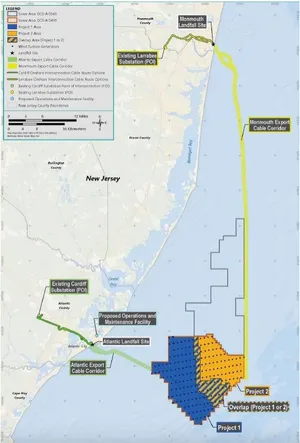Key Takeaways
The developers of the Atlantic Shores wind project formally requested New Jersey authorities to cancel key regulatory agreements, as the project was no longer commercially viable under the current economic and political conditions.
The cancellation is a major blow to the state’s offshore wind goals and the development of the U.S. offshore wind sector.
However, it is a win for American households as offshore wind is a very expensive, weather-driven, and, thus, intermittent generating technology that requires backup power in the form of duplicate generating technologies or costly batteries.
Despite the cancellation, the company claims the project is in a holding pattern awaiting a new political climate.
Atlantic Shores Offshore Wind petitioned the New Jersey Board of Public Utilities to terminate its Offshore Renewable Energy Certificates (ORECs) order due to economic and political headwinds. Terminating this order cancels its offshore wind power project in New Jersey. The company, which is a partnership between UK-Dutch oil company Shell and France’s EDF Renewables North America, was in the process of developing a 1.5-gigawatt wind turbine power project east of Atlantic City. Despite the cancellation of its contract with New Jersey, the company claims its project is in a holding pattern while awaiting a new political climate.
In 2021, the New Jersey Board of Public Utilities awarded Atlantic Shores the ORECs. This funding mechanism incentivizes the production of offshore wind energy in New Jersey, which includes a 30% federal investment tax credit. According to Asbury Park Press, the company, as part of its initial agreement with the Board of Public Utilities, promised to invest in manufacturing at the state’s Wind Port and to lease space there at a cost of approximately $35.6 million over a two-year period. The company also planned to build an operations facility in Atlantic City, which would employ approximately 88 people. Additionally, it was committed to investing $16 million in a pilot project for a hydrogen power plant and intended to spend an additional $4 million on workforce development programs.
However, in concert with President Trump’s executive order on wind energy, in March, the U.S. Environmental Protection Agency’s Environmental Appeal Board pulled an air permit granted to the company in 2024 — a permit that the company needed to move forward with construction. In an earlier setback, Shell withdrew from the project in January, writing off nearly $1 billion. In its quarterly earnings report on January 30, Shell disclosed a $996 million loss associated with the Atlantic Shores project to build the 2,800-megawatt array of 197 turbines off Long Beach Island and Brigantine. Following in Shell’s footsteps, in February, EDF booked an impairment charge of about $980 million.
Wind Turbine Locations and Power Cable Routes of Proposed Atlantic Shores Offshore Wind Project

The permit removal, along with President Trump’s executive order and other actions taken by the current administration more generally, forced the company to reduce its personnel, terminate contracts, and cancel planned project investments, according to the OREC filing to the utilities board.
Background
In 2018, New Jersey Governor Phil Murphy issued an executive order setting a goal for offshore wind to generate 3.5 gigawatts of electricity in the state by 2030. Governor Murphy amended that goal to 7.5 gigawatts of offshore wind energy by 2035 in 2019. No offshore wind project has yet begun construction, and the Governor’s timeline appears at risk in the current political and economic climate. Ørsted, a Danish wind company, abandoned two major New Jersey offshore projects in late 2023, citing cost increases and permitting delays, despite the Biden administration’s repeated efforts at lowering royalties, easing permitting, streamlining environmental documentation, and providing generous wind subsidies.
For offshore wind, which is a costly power source, to be economic, it must be guaranteed a certain price for its power. The NJ Board of Public Utilities signs contracts with offshore wind developers to supply electricity at a specific rate. Electricity providers in the state must purchase that power as part of compliance with the state’s renewable energy goals outlined in the 2010 Offshore Wind Development Act. Citing inflation primarily due to the COVID-19 lockdowns and the Russian invasion of Ukraine, Atlantic Shores had submitted an updated bid for its projects this year that would increase the price for the electricity it generates. However, because the Board of Public Utilities cancelled a bid for proposals in February, the company was unable to receive a price increase.
According to Intellinews, the company had once touted the Atlantic Shores project as one of the most advanced offshore wind proposals in the state, with ambitions to develop a broader 2.8-gigawatt offshore wind portfolio through its additional lease holdings. Atlantic Shores currently holds three lease areas off the New Jersey coast, spanning more than 1,036 square kilometers, including locations near Atlantic City and within the New York Bight, which is a triangular indentation along the Atlantic coast of the United States that extends northeasterly from Cape May Inlet in New Jersey to Montauk Point on the eastern tip of Long Island.
Conclusion
The developers of the Atlantic Shores wind project formally requested New Jersey authorities to cancel key regulatory agreements, which is not only a major blow to the state’s offshore wind goals but also to the development of the U.S. offshore wind sector. Both Shell and EDF noted that the project was no longer commercially viable under the current economic and political conditions. The cancellation, however, is a win for American households as offshore wind is a very expensive, weather-driven, and thus intermittent generating technology that requires backup power in the form of duplicate generating technologies or very expensive batteries that store excess energy. Despite the cancellation of its contract, however, the company claims the project is in a holding pattern awaiting a new political climate.



